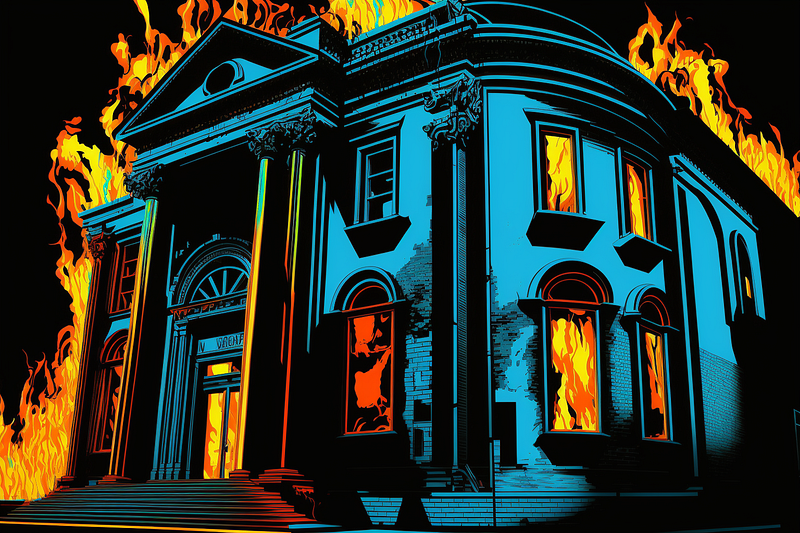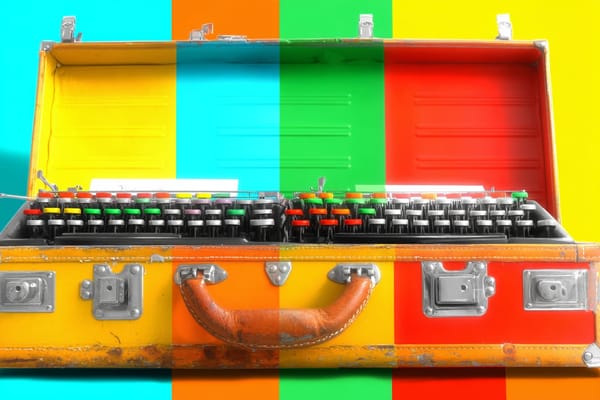What’s Going On? The Silicon Valley Bank Collapse vs. the 2008 Financial Crisis
Confused? Here’s a simple (yet thorough!) explainer.

Ever heard the phrase “Explain it like I’m 5”? It means taking a complex topic and breaking it down into terms that a 5-year-old can understand.
Over the past few days, I’ve watched a lot of commentators explain the collapse of Silicon Valley Bank. They’re talking about insured deposits, venture capital, ripple effects on the economy…. but what do those things even mean?
I worked in banking during the 2008 financial crisis (at a tech company with banks as clients). Now I’m a freelance content marketer and most of my clients are venture capital-backed tech companies. So I’ve had a front-row seat for both crises.
There’s plenty of information for founders and business owners right now, but what about regular people? Here’s some background about what happened and what it means.
What happened in 2008?
For several years leading up to the 2008 financial crisis, some banks were engaged in risky business.
The real estate market was booming. So banks were making a lot of loans for commercial real estate (business) and consumer real estate (mortgages).
The problem was that banks also relaxed their underwriting standards to do these loans. That means that maybe five years prior, the bank would have said “Nah, you can’t afford that loan.” And instead, said “Okie dokie — here’s your loan!” (Subprime lending was a big problem — banks were knowingly doing loans to borrowers with lower credit scores or other risk factors).
There were several layers of risk for the borrowers. One is that some loans had an adjustable interest rate: meaning the rate can change over time. When the rate changes (up or down), the monthly payment amount also changes. And the other risk was that the value of the real estate was abnormally high. A few years earlier, a house may have only been worth $275,000, and now it was worth $450,000. So banks were doing loans based on the house’s current value of $450,000.
That real estate boom? Turns out it was a bubble. And like all bubbles, it eventually burst. The interest rates went UP and the real estate values went DOWN. Meaning lots of people and business owners could no longer afford their monthly payments.
When borrowers can’t make their payments, it’s a problem for the bank. They’re relying on those loans being paid back. A few bad loans are normal, but this was an overwhelming number for banks that had done too many risky loans. And loan payments are income for the bank.
Banks keep money in a “rainy day fund” (called reserves) to cover bad loans. But the number of bad loans far exceeded their reserves and the banks were in trouble.
What is a bank failure?
A bank failure happens when the Federal Deposit Insurance Corporation (FDIC) steps in and says, “Enough. You don’t get to do business anymore.”
Typically, bank failures are not a surprise. The bank will have been struggling for awhile. The FDIC will tell the bank, “Hey, you need to get your act together” or “Hey, you need to raise additional money (capital) to cover some of these losses you’re experiencing.”
The FDIC will show up at the bank’s doorstep — at all branches — and shut the bank down. This part happens without warning, because if word leaked in advance, it could cause panic at the bank. The FDIC informs the bank that they no longer exist and spends one weekend taking over the bank. By Monday morning, the bank reopens, either under new ownership or the FDIC’s control.
The FDIC will try to find a buyer for a troubled bank in advance, through a very secretive process. Finding a buyer ensures a really smooth transition for bank customers.
Usually, the buyer is another (larger) bank. Why would one bank buy a troubled bank? Because the troubled bank is basically “on sale” — the buyer can get the bank’s assets and customers for a lot cheaper than a typical merger or growing its current bank.
What are insured deposits?
The FDIC was created in 1933 in response to the Great Depression. For some perspective, about 4,000 banks failed during that time period. Before the FDIC was created, depositors simply lost their money.
The FDIC was a way to reassure depositors that their money was safe in a bank. FDIC insurance provides that when a bank fails, all deposits up to the insurance limit are protected.
Banks pay for FDIC insurance. They send money to the FDIC and the FDIC sticks that money in a reserve, just in case it has to be paid out due to a bank failure. If you look at the bottom of a bank’s website, it will say “FDIC Insured” and that reassures depositors that it’s a “real” bank.
Starting in 1933, the deposit insurance limit was $100,000. In response to the 2008 financial crisis, that limit was raised to $250,000. It’s important to note that the limit is per deposit holder, not per account. So if you have three accounts at one bank, your total among all accounts is $250k.
Is $250k a lot? Probably — for most individuals. But businesses may routinely need more than $250k in their accounts, just as a normal course of doing business. Like a hotel that does more than $250k in room reservations per night. Or a consulting firm with 10,000 employees that pays out more than $250k with every pay period.
Having more than $250k in an account isn’t a problem — unless the bank fails.
At the height of the financial crisis, about 100 banks per year were failing. That seems like a small number compared to 1933, but there are also far fewer banks now than back then. We now have large regional banks and megabanks. There are fewer than 5,000 unique banks in the U.S. (and about another 5,000 credit unions).
But over the past few years, there haven’t been many bank failures. There were four in 2020 and none in 2021. Even amidst the pandemic, banks did ok (actually, some did more than ok but I’ll get to that in a bit).
What made SVB unique?
Every bank makes decisions about the types of customers it wants. Some want to work with farmers. Others focus on small businesses. Or have really good rates on car loans. That’s what sets them apart from other banks.
Typically, banks will end up with a mix of customers. What caused a lot of banks to fail in 2008 was that they had too many real estate loans. Banks with a smaller number of real estate loans (or a more well-balanced portfolio) were ok: even if those loans went bad, it wasn’t enough to drag the entire bank down.
SVB was a very unique bank. It catered specifically to tech and healthcare startups. Other banks might find these types of customers “too risky”: there is inherently more risk in a startup than in an established business. But, founded in 1983, SVB said, “Come to us for your banking needs — we’ll help you out!”
At the time of the SVB failure, it was the 16th largest bank in the United States, with assets of more than $200 billion. $200b is very large, but the “Top 5” (the largest banks in the U.S.) have assets in the trillions. By comparison, a large regional bank might have assets of around $10 billion.
The other unique thing about SVB was that it only had 17 branches (in California and Massachusetts). A similarly sized bank would typically have hundreds of branches. SVB also operated branches in the UK, Canada, China, India, and several other countries.
What has been going on in banking lately?
When the pandemic hit in 2020, a lot of banks were very fearful. They feared that their borrowers were going to go bankrupt or businesses would close and a lot of loans would go bad — across multiple industries. That would have been a lot different than the bad loans of 2008, which were mostly in real estate.
But thanks to government assistance to individuals and businesses, that didn’t happen. Small businesses could get Paycheck Protection Program loans and individuals could have their mortgage payments paused for a few months. It was enough to weather the storm.
Then the Federal Reserve (the Fed) dropped interest rates in an attempt to stimulate the economy. It worked, for mortgages in particular. Lots of borrowers flocked to their banks to refinance their mortgages to historically low rates. And at the same time, the value of homes kept rising (can we say 2008 real estate bubble flashbacks?)
But banks faced another problem. Overall, customers were spending a lot less, which means they had more money in the bank. Banks earn money from the interest they charge on loans and lose money on the interest they have to pay on deposit accounts (the difference between the two is Net Interest Margin).
With customers keeping more cash in the bank, banks had to think of other ways to earn money. The best way (for many banks) was to try and encourage more loans.
Then the Fed said, “Ok, that’s enough — now we’re seeing inflation and that’s no good” and started raising interest rates again. In early 2022, interest rates were near 0%. Now they’re at 4.5% (and banks charge interest rates above the Fed rate so what customers see is a bit different). It’s been the fastest rate hike since the 1980s.
What has been going on in tech, specifically?
Tech companies saw a major increase in demand for their services during the pandemic. E-commerce companies saw a huge spike in interest for online shopping. Any company that enabled remote work was in high demand. And digital products and services overall just skyrocketed.
Tech startups — specifically the types of customers that SVB worked with — needed more money to fuel their growth. Non-tech businesses would typically go to a bank and ask for a loan and use the loan to hire more staff, increase their inventory, open a new location, etc.
But tech startups raise money through venture capital. One reason is that traditional banks require collateral: some type of physical asset that supports the loan. If the loan goes bad, the bank takes possession of the asset.
For a homeowner, the collateral is your home. If you can’t pay your mortgage, the bank will take possession of your house. For a business, collateral is the assets of the business. Let’s say the business is a pizza parlor. The assets would be the refrigerators, the ovens, the delivery trucks, the building (if the business owns the building) and anything else that the business owns.
Many tech startups don’t have the same type of physical assets. If they operate something like “an online productivity app” — what is the asset? The code base?
So instead, tech companies often raise money through venture capital (VC). VC firms will give tech companies tens of millions of dollars to fund their growth. And throughout 2021, VC was on fire. Tech companies were literally swimming in money. And they took their cash from VC funding and parked it at SVB until they needed it.
What happened at SVB?
SVB faced the same problem that many banks were facing: too much cash sitting in deposits. But while other banks turned around and tried to do more loans, SVB had another unique problem: its customers could get money from venture capitalists. They didn’t need loans.
So SVB took the money and bought Treasury securities. A low-risk investment and a seemingly prudent thing to do with the extra cash… until the Fed began raising interest rates. Suddenly that investment was worth a lot less.
Meanwhile, the tech industry had taken a beating. The growth of 2021? Was more like a blip. VC-backed tech companies laid off tens of thousands of employees, trying to preserve their cash. They weren’t able to raise new rounds of VC funding. And they started pulling cash out of their accounts at faster rates — which had a big impact on SVB.
With an increased demand for cash from its account holders and sitting on this bad investment, SVB decided to cut its losses and sell the securities — at a loss of $1.8 billion. So then, SVB decided to raise capital itself (to the tune of $2 billion) to cover the loss. All fairly normal business decisions.
What is a “run on the bank”?
If you’ve ever seen the movie It’s a Wonderful Life, you might remember the run on the bank. Everyone lined up at the Bailey Building and Loan and demanded their money. And George Bailey said:
You’re thinking of this place all wrong — as if I had the money back in a safe. The money’s not here. You’re money’s in Joe’s house, and the Kennedy house and Mrs. Macklin’s house, and a hundred others.”
That’s the way banks work. They take deposits and turn them into loans. The system works fine, unless every depositor shows up at the bank’s door and wants to withdraw money at the same time.
When SVB announced that it was trying to raise capital to cover the $2B loss, it made the announcement without a lot of context. It spooked some venture capitalists into thinking that the bank was in trouble. Those VCs, in turn, advised their tech companies to start pulling money out of the bank.
Suddenly, within about a day’s time, SVB was in trouble. Everyone had shown up to take out their money. So instead of looking to raise capital, SVB began looking for a buyer. And that news made a bad situation worse.
In an extraordinary move, the FDIC shut the bank down midday on Friday, March 10th. Usually, the FDIC will close a bank at 5:00 pm (when it is planned in advance). But the bank had become so rapidly insolvent that the FDIC said it couldn’t wait any longer. At the time of closure, about 25% of deposits had been withdrawn from the bank in a 48-hour timeframe.
It was a classic run on the bank.
What will happen to SVB deposits?
After shutting down a bank, it ceases to exist. The FDIC formed a new bank called the Deposit Insurance National Bank of Santa Clara, and the bank will reopen for business on Monday, March 13th.
Now the FDIC insurance limit comes into play. The customers of SVB will only be able to access $250k of their money on Monday morning, the maximum guaranteed by the FDIC.
But due to the unique nature of SVB customers, that they were mostly tech companies, and venture capital-backed at that, over 90% of SVB customers had more than $250k in their accounts. Some had millions. Some (like Roku) had hundreds of millions. That money will be gone.
According to the Washington Post, SVB required some of its customers to maintain an exclusive relationship with the bank. Meaning that instead of spreading its cash among multiple banks, the company had all of its money with SVB.
Will it be permanently gone? It depends on what happens to the former SVB. The FDIC will try to quickly find a buyer. When Washington Mutual failed in 2008 (the largest bank failure in history, at $300 billion), JP Morgan Chase bought the bank and all depositors were made whole. No one lost any money.
JP Morgan Chase bought WaMu because it was a good business deal — it was able to expand its bank presence into a new area of the country by acquiring all of the WaMu branches. And WaMu, other than being overly concentrated in real estate, wasn’t as unique as SVB. So finding a buyer for SVB might be trickier.
And even if a buyer is found, there’s no way of knowing how quickly that transition will happen and if the buyer will assume all deposit accounts of SVB.
If the FDIC can’t find a buyer, it will sell the assets of SVB and pay back depositors that had balances above $250k. There’s no way of knowing how long that process could take (could be years) and no way of knowing if the FDIC will be able to sell the assets for enough money to cover the uninsured deposit amounts.
Meanwhile, many startups are facing very real cash flow problems. They have employees to pay and other expenses. Without access to any money above $250k, the future is very uncertain.
What is the Dodd-Frank Act?
After the 2008 financial crisis, Congress passed the Dodd-Frank Act. Among other things, the Dodd-Frank Act required banks to submit to “stress tests” — or what-if scenarios that could test their ability to respond in a crisis. Banks over $50 billion had to submit annual stress tests. The Act also outlined minimum capital requirements for banks.
But in 2018, the threshold for Dodd-Frank requirements changed from $50 billion to $250 billion. The Act was intended to make sure that “too big to fail” banks remained in check. The argument was that a $50 billion bank wasn’t big enough to cause catastrophic problems on the financial industry.
Former SVB CEO Greg Becker was an advocate for raising the threshold. At the time, SVB was $50 billion. By increasing the threshold, SVB was no longer subject to Dodd-Frank stress testing and capital requirements at the time of its failure.
What are the biggest differences between 2008 and SVB?
In some ways, the 2008 financial crisis and what happened at SBV were polar opposites.
The 2008 financial crisis was the result of loans that went bad. SVB failed because of the run on deposits.
The 2008 financial crisis was the result of some banks engaging in risky lending behavior (and some, very knowingly).
SVB was a bit different. The biggest risk was being so concentrated in the tech industry.
In 2008, there was a buildup over many, many months of loans slowly going bad. It wasn’t overnight. While you could argue that there was a tech bubble waiting to burst, and truly tech companies have been struggling for months, the demise of SVB happened in 48 hours.
For a majority of failed banks in 2008–2010 timeframe, the FDIC had worked out a deal in advance for a buyer to take over the bank. With SVB, there was no buyer lined up.
The other reason that SVB collapsed with stunning speed is because of the tech-savviness of its clientele. VC firms may have been paying more attention to SVB’s financial situation than an ordinary customer. When these firms saw that SVB was trying to raise money, they put out an alert to their tech clients. Social media, Slack, and the tightly-knit tech startup world caused the news to spread like wildfire — ultimately leading to the run on the bank.
What are the potential ripple effects?
There has been lot of backlash on social media, claiming that SVB was the home of rich tech companies and venture capitalists.
True. But it was also a mecca for small startups. Those startups may have become larger startups over time, but their expenses (including payroll) would have also grown.
And all of this is on the heels of a very rough patch in the tech world. Tech companies that were already squeezed have now been squeezed even more. Many may not survive. Certain states require companies to pay workers promptly, meaning if the company doesn’t immediately have access to cash for payroll, they’ll have to furlough or lay off employees.
Even companies that didn’t keep money at SVB may have been doing business with companies that had money at SVB. The SVB account holders may no longer be able to pay their bills, causing an even greater impact.
Some hedge funds have been reportedly reaching out to impacted deposit customers, offering 60 to 80 cents on the dollar for their accounts. And stressed company owners might be tempted, thinking that they might not otherwise see their money again.
And the idea that any money over $250k is at risk might send shockwaves through the financial system overall. Companies — even outside of tech — with money at small and regional banks may decide that it’s less risky to keep their money with a “too big to fail” bank, like the big national banks. Could it trigger a run on these other banks? Possibly.
Ultimately, when deposits leave community and regional banks, the communities suffer. Without the deposits, these banks can’t do as many loans — loans that often stay within the community. These banks have been slowly dwindling over time, gobbled up by the large national banks. If large banks become the only perceived safe haven for company deposits, it’ll further cripple the community banking world.
What does all of this mean for you?
Maybe you’re not employed by a tech company. Maybe you hate venture capital. Maybe you think that a government bailout — protecting depositors above $250k — is a bad idea.
But there’s no denying that the failure of SVB could have a stunning impact on the economy.
President and CEO of startup investor Y Combinator said, “I think a whole generation of startups will be wiped off the planet” (without intervention).
Think of the healthcare technology that your doctor’s office may use. Or your favorite app on your phone. Even people that don’t work in tech or tech-adjacent fields use the technology that these startups brought to the world.
And maybe you’re not that interested in technology. But the failure of more banks could be devastating. This country continues to be powered by banks outside of the Big 4. If businesses collectively consolidate their deposits into those banks, others will collapse. The banking industry, overall, has seen intense consolidation over the past few decades as smaller institutions aren’t able to compete.
We need to collectively understand that SVB’s failure impacts all of us — and have a vested interest in mitigating the damage.
How did the U.S. government step in?
At 6:15 pm EST on Sunday, March 12th, the Treasury, the Fed, and the FDIC issued a joint statement that actions had been approved to fully protect all depositors. All accounts at SVB will have full access to all of their money on Monday morning.
The regulators enacted a “systemic risk exception” to the $250k limit. This was used several times during the 2008 financial crisis to protect depositors. No taxpayer money is used. The bank management team is fired. And the investors of SVB are not protected.
Only the depositors are protected. Because no account holder should be harmed when their bank fails. Most people and businesses don’t keep track of their bank’s overall financial health and no one should feel that their money is not safe at a bank.
The FDIC will dig a little deeper into its reserves. And, if there is a shortfall, all FDIC-insured banks will pay a “special assessment” (which is required by law). Kind of like living in a condo association and there’s a leak in the roof and the association says, “Yeah, here’s the bill for all homeowners in the association to fix the roof of one unit because that’s what it means to be part of this community.”
This was done to prevent a meltdown of the financial system — a system built on trust that your money is safe in the bank. The implications were broad not only for all depositors in the U.S., but the global markets that were also keeping an eye on the situation.
And it was rightfully a sigh of relief for the tens of thousands of businesses that banked with SVB. The hundreds of thousands of employees of those businesses. People, like me, who spent the weekend wondering about the fallout. Wondering if their livelihoods were about to be upended.
It was a brief moment of crisis, but — hopefully — over. There will be commentary, opinions, and questions of, “Could this have been prevented?” All of those are secondary to protecting the innocent bystanders of SVB’s collapse.
I tried my best to explain all of this! There’s a lot of information flying around, but few articles I’ve read give a full picture. I’ve also written a follow-up with some additional thoughts, rather than continue to edit this article.
If you want to support my work as a writer, you can buy me a coffee. You can also subscribe to my Substack for more thoughts on work culture and the future of work. Connect with me on LinkedIn and Threads.





